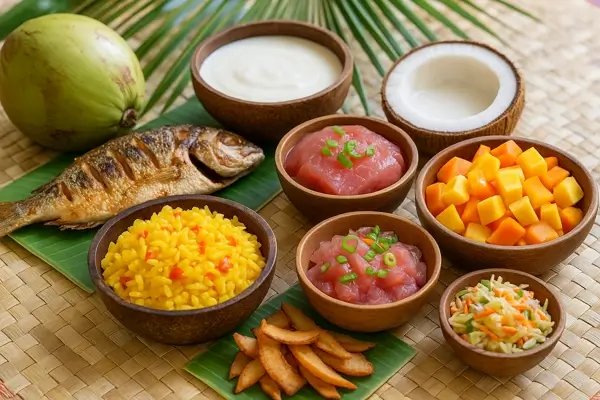
Kiribati, an island nation located in the central Pacific Ocean, boasts a unique and diverse cuisine that reflects its rich cultural heritage and tropical surroundings. Kiribati's traditional dishes are deeply rooted in the abundant resources of the ocean and the bountiful produce of the land. Let's explore some of the national dishes and local specialties that make Kiribati's cuisine a fascinating culinary experience.
Palu Sami: Palu Sami is a traditional dish made with young coconut meat, breadfruit, and fish. The ingredients are wrapped in banana leaves and cooked in an earth oven known as a "umu." The result is a flavorful and aromatic dish that showcases the natural sweetness of the coconut and the savory taste of the fish. Recipe
Ei: Ei is a Kiribati staple made from grated pulaka (swamp taro) or breadfruit mixed with coconut cream. It is often served as a side dish or accompaniment to main courses. Ei has a creamy texture and a subtle sweetness that complements many other Kiribati dishes.
Ika Mata: Ika Mata is a traditional Kiribati ceviche-style dish made with fresh fish marinated in lime or lemon juice and coconut cream. The fish is typically diced and mixed with chopped vegetables such as tomatoes, onions, and chilies. Ika Mata is a refreshing and tangy dish that highlights the flavors of the sea. Recipe
Te Inaina: Te Inaina is a Kiribati dessert made from ripe bananas, grated coconut, and sugar. The ingredients are combined and wrapped in banana leaves before being steamed or baked. Te Inaina has a moist and sweet taste, making it a popular treat among locals and visitors alike.
Palu Fai: Palu Fai is a traditional Kiribati pudding made from grated pulaka (swamp taro), coconut cream, and sugar. The ingredients are mixed together and baked until the pudding is firm and golden. Palu Fai has a creamy texture and a delicate sweetness that makes it a comforting dessert.
Kakakai: Kakakai is a Kiribati delicacy that consists of land crabs cooked in coconut milk and various seasonings. The crabs are typically stewed until tender, allowing the flavors to infuse the meat. Kakakai is a rich and savory dish that showcases the island's seafood bounty.
Tebabwanga: Tebabwanga is a Kiribati beverage made from fermented coconut sap. The sap is collected from the blossoms of the coconut tree and left to ferment naturally. Tebabwanga has a mildly sweet and tangy taste and is often enjoyed on special occasions and gatherings.
These are just a few examples of the national dishes and local specialties that Kiribati has to offer. Its cuisine is deeply connected to the land and sea, with an emphasis on fresh ingredients and traditional cooking methods. Exploring Kiribati's culinary delights is a delightful way to experience the unique flavors and food culture of this beautiful island nation.
